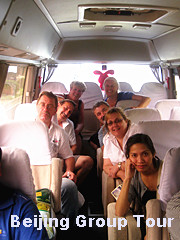 Forbidden City
Forbidden City
 |
The Forbidden City, aslo known as the Imperial Palace Museum, was the imperial palace of the Ming and Qing dynasties. In early 15th century, the capital of the Ming Dynasty was moved from Nanjing to Beijing. Twenty-four emperors of the Ming and Qing dynasties ruled from the Forbidden City. |
 The layout of the Forbidden City is based on a Chinese cosmic diagram of the universe that clearly defines the north-south and east-west axes. The buildings represent the largest and best-preserved examples of Chinese traditional architecture found today. The overall layout is centered on the three primary Halls of State: The Hall of Supreme Harmony (Taihedian), The Hall of Middle Harmony (Zhonghedian) and The Hall of Preserving Harmony (Baohedian). State ceremonies were held in the Outer Court (Wai Chao) of the Forbidden City. Here the emperors governed from their thrones, holding court sessions with their ministers, issuing imperial edicts and initiating military expeditions. The Outer Court was also the site for important ceremonies: the accession of a new emperor to the throne, birthdays, and weddings. The Inner Court (Nei Ting) was the residential area of the emperor and the imperial household, as well as the place where the emperor dealt with routine state affairs.
The layout of the Forbidden City is based on a Chinese cosmic diagram of the universe that clearly defines the north-south and east-west axes. The buildings represent the largest and best-preserved examples of Chinese traditional architecture found today. The overall layout is centered on the three primary Halls of State: The Hall of Supreme Harmony (Taihedian), The Hall of Middle Harmony (Zhonghedian) and The Hall of Preserving Harmony (Baohedian). State ceremonies were held in the Outer Court (Wai Chao) of the Forbidden City. Here the emperors governed from their thrones, holding court sessions with their ministers, issuing imperial edicts and initiating military expeditions. The Outer Court was also the site for important ceremonies: the accession of a new emperor to the throne, birthdays, and weddings. The Inner Court (Nei Ting) was the residential area of the emperor and the imperial household, as well as the place where the emperor dealt with routine state affairs.
 This magnificent, palatial architectural complex of Forbidden City, covers an area of over 2,350,000 square feet and contains 9,999 rooms. The largest complex of its kind in the world, it is surrounded by ten-foot-high walls that are crowned by four observation towers and flanked by a deep moat. The walls are pierced by four large gates, each with three openings and a broad crowning pavilion.
This magnificent, palatial architectural complex of Forbidden City, covers an area of over 2,350,000 square feet and contains 9,999 rooms. The largest complex of its kind in the world, it is surrounded by ten-foot-high walls that are crowned by four observation towers and flanked by a deep moat. The walls are pierced by four large gates, each with three openings and a broad crowning pavilion.
The Forbidden City was the scene of many significant events affecting the course of Chinese history. Today, the Forbidden City is one of the world's foremost museums of Chinese art. Its palaces and halls are filled with innumerable works of art and cultural artifacts, including gifts of state, military campaign loot and furnishings and possessions of members of the imperial households. A great number of these treasures represent the peak of artistic and inventive genius exhibited by the countless artisans who worked exclusively for the imperial court.
The Forbidden City now has become one of the most popular tourist attractions in the world.
China Attractions
- Beijing Attractions
- Shanghai Attractions
- Xian Attractions
- Guilin Attractions
- Guangzhou Attractions
- Lhasa Attractions
- Yangshuo Attractions
- Hangzhou Attractions
- Nanjing Attractions
- Huangshan Attractions
- Wuhan Attractions
- Dali Attractions
- Harbin Attractions
- Suzhou Attractions
- Kunming Attractions
- Pingyao Attractions
- Xinjiang Attractions
- Kashgar Attractions
- Chengdu Attractions
- Sanya Attractions
- Lijiang Attractions
- Datong Attractions
- Dunhuang Attractions



